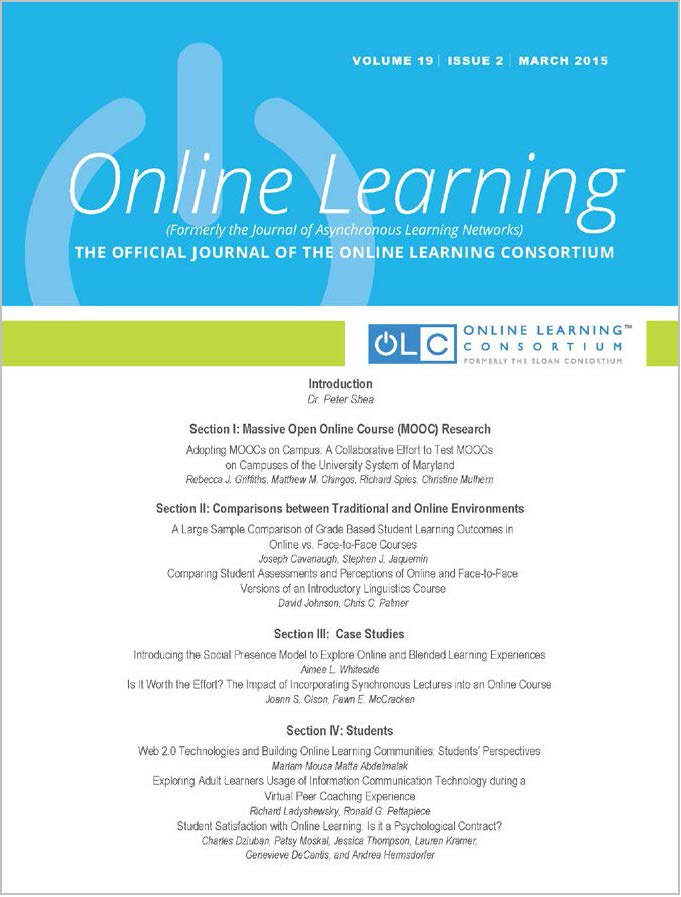A Large Sample Comparison of Grade Based Student Learning Outcomes in Online vs. Face-to-Face Courses
DOI:
https://doi.org/10.24059/olj.v19i2.454Keywords:
Online education, online grade comparison, student performance, online vs. face-to-face, assessmentAbstract
Comparisons of grade based learning outcomes between online and face-to-face course formats have become essential because the number of online courses, online programs and institutional student enrollments have seen rapid growth in recent years. Overall, online education is largely viewed by education professionals as being equivalent to instruction conducted face-to-face. However, the research investigating student performance in online versus face-to-face courses has been mixed and is often hampered by small samples or a lack of demographic and academic controls. This study utilizes a dataset that includes over 5,000 courses taught by over 100 faculty members over a period of ten academic terms at a large, public, four-year university. The unique scale of the dataset facilitates macro level understanding of course formats at an institutional level. Multiple regression was used to account for student demographic and academic corollaries—factors known to bias course format selection and grade based outcomes—to generate a robust test for differences in grade based learning outcomes that could be attributed to course format. The final model identified a statistical difference between course formats that translated into a negligible difference of less than 0.07 GPA points on a 4 point scale. The primary influence on individual course grades was student GPA. Interestingly, a model based interaction between course type and student GPA indicated a cumulative effect whereby students with higher GPAs will perform even better in online courses (or alternatively, struggling students perform worse when taking courses in an online format compared to a face-to-face format). These results indicate that, given the large scale university level, multi course, and student framework of the current study, there is little to no difference in grade based student performance between instructional modes for courses where both modes are applicable.References
Allen E. and Seaman J. Changing Course: Ten Years of Tracking Online Education in the United States January 2013 Babson Survey Research Group and Quahog Research Group, LLC. http://www.onlinelearningsurvey.com/reports/changingcourse.pdf
Ashby J., Sadera W. A. and McNary S. W. Comparing student success between developmental math courses offered online, blended, and face-to-face. Journal of Interactive Online Learning 10(3):128-140 (2011). www.ncolr.org/jiol
Larson D. K. Comparing Student Performance: Online Versus Blended Versus Face-to-Face. Journal of Asynchronous Learning Networks 13(1):31-42 (2009).
McLaren, Constance H. A Comparison of Student Persistence and Performance in Online Classroom Business Statistics Experiences Decision Sciences. Journal of Innovative Education 2(1):1-10 (2004).
Driscoll A., Jicha K., Hunt A. N., Tichavsky L. Thompson G. Can online courses deliver in-class results? A comparison of student performance and satisfaction in an online versus a face-to-face introductory sociology course. Teaching Sociology 40(4):312-331 (2012)
Jaggars S. S., Edgecombe N. and Stacey G. W. Community College Research Center Teachers College, Columbia University What We Know About Online Course Outcomes. Research Overview 1-7 (2013).
Xu D. and Jaggars S. S. The impact of online learning on students’ course outcomes: Evidence from a large community and technical college system. Economics of Education Review 37:46–57 (2013).
Atchley W., Wingenbach G. and Akers C. Comparison of Course Completion and Student Performances through Online and Traditional Courses International. Review of Research in Open and Distance Learning 14(4):104-116 (2013).
Calafiore P. and Damianov D. S. The Effect of Time Spent Online on Student Achievement in Online Economics and Finance Courses The Journal of Economic Education. 42(3):209–223 (2011).
Hollister K. K. and Berenson M. L. Proctored Versus Unproctored Online Exams: Studying the Impact of Exam Environment on Student Performance Decision Sciences. Journal of Innovative Education. 7(1):271-294 (2009).
Hallock D., Satava D. and LeSage T. An Exploratory Investigation of the Potential Relationship Between Student Learning Styles, Course Grade, Cumulative Grade Point Average and Selected Demographics in On-Line Undergraduate Business. Courses Management Research News. 26(1):21-28 (2003).
Fox J. and Weisberg S. (2011). An R companion to applied regression. 2nd edition. Sage Publishing. Thousand Oaks, CA, USA.
Dalal D. K. and Zickar M. J. Some common myths about centering predictors in moderated multiple regression and polynomial regression. Organization Research Methods. 15 339-362 (2012).
R Core Team (2013) R: A language and environment for statistical computing. R Foundation for Statistical Computing, Vienna, Austria. URL http://www.R-project.org/
Cavanaugh, J. K. Are Online Courses Cannibalizing Students From Existing Courses? Journal of Asynchronous Learning Networks. 9(3), 3-8 (2005). http://sloanconsortium.org/jaln/v9n3/are-online-courses-cannibalizing-students-existing-courses
Aslanian, C. B., and Clinefelter, D. L. (2013) Online college students 2013: Comprehensive data on demands and preferences. Louisville, KY: The Learning House, Inc. http://www.learninghouse.com/ocs2013-report/
Xu D. and Jaggars S. S. The Effectiveness of Distance Education Across Virginia's Community Colleges: Evidence From Introductory College-Level Math and English Courses. Educational Evaluation and Policy Analysis. 33(3):360-377 (2011).
Stewart, C., Bachman, C., and Johnson, R. Students’ characteristics and motivation orientations for online and traditional degree programs. Journal of Online Learning and Teaching. 6(2):367−379 (2010).
Xu D. and Jaggars S. S. Adaptability to Online Learning: Differences Across Types of Students and Academic Subject Areas. CCRC Working Paper No. 54 1-32 (2013). http://ccrc.tc.columbia.edu/publications/adaptability-to-online-learning.html
Downloads
Published
Issue
Section
License
As a condition of publication, the author agrees to apply the Creative Commons – Attribution International 4.0 (CC-BY) License to OLJ articles. See: https://creativecommons.org/licenses/by/4.0/.
This licence allows anyone to reproduce OLJ articles at no cost and without further permission as long as they attribute the author and the journal. This permission includes printing, sharing and other forms of distribution.
Author(s) hold copyright in their work, and retain publishing rights without restrictions






